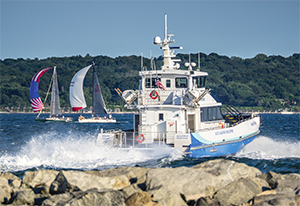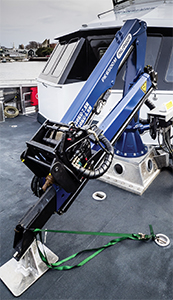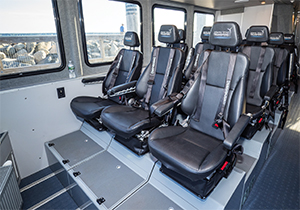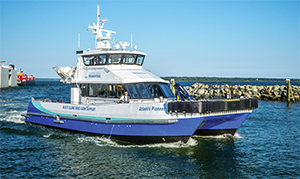On a blue-sea, blue-sky day at Quonset Point in North Kingstown, R.I., Atlantic Pioneer cleared the breakwater and entered Narragansett Bay. When Capt. Jordan Ryan lay on the throttles, the stern dug in and the bow rose up and over, throwing an impressive display of white water.
Atlantic Pioneer is the first crew transfer vessel (CTV) purpose-built in the United States to support offshore wind farm construction and maintenance. The aluminum catamaran, with three offshore workers aboard, was speeding to the Deepwater Wind LLC site — the first offshore wind farm in the country, under construction in 90 feet of water three miles southeast of Block Island, R.I. The speedster was designed by South Boats IOW in the United Kingdom and constructed for Atlantic Wind Transfers by Blount Boats of Warren, R.I.
Atlantic Wind Transfers is at the forward edge of what promises to be a growth industry on the Atlantic coast. The 70-foot Atlantic Pioneer was built to meet a 20-year contract to service the Deepwater Wind site. When completed this fall, the Block Island tract will consist of five turbines, supplying the island with electric power that currently is provided by diesel generators.
“There are three more tracts set to be developed between Block Island and Martha’s Vineyard,” said Charles Donadio Jr., founder and president of Atlantic Wind Transfers and its parent company, Rhode Island Fast Ferry, both based at Quonset Point. “That’s roughly 80 minutes off my dock.”
 |
|
Capt. Jordan Ryan checks the radar as the boat heads for the Deepwater Wind site. |
Donadio has more than 20 years of experience operating fast catamaran ferries in the waters encompassing Narragansett Bay, Block Island and Martha’s Vineyard. He watched the growth of the offshore wind farm vessel market in Europe with interest. When offshore wind farm proposals surfaced along the northeast Atlantic coast, he saw opportunity.
“Given my terminal location, which is logistically the closest to this wind farm as well as the other three large tracts that are set to be developed, it made sense,” he said. “This is what we do. We transport passengers on much larger fast ferries, so it’s not any different than what we are doing now.”
Atlantic Pioneer is based on South Boats’ 21-meter offshore support vessel design. The Isle of Wight company specializes in the design and construction of a broad range of fast offshore workboats. With more than 80 of its CTVs plying the offshore wind farms of Europe, it has garnered the lion’s share of the region’s wind energy support market.
Atlantic Wind Transfers customized and equipped Atlantic Pioneer for offshore support and for passenger service. To that end, the vessel carries a U.S. Coast Guard Subchapter L (offshore supply vessel) classification to carry up to 16 offshore workers and a Subchapter T classification to carry up to 47 passengers.
 |
|
The starboard MAN D2862 LE 466 main engine, upper right, delivers 1,400 hp. |
“We were able to achieve a dual certification so that we can make the vessel more versatile,” Donadio said. “South Boats has been doing this longer than anybody else overseas and owns the majority of the market share. The evolution of the vessel’s design has been ongoing for over a decade overseas, so why go out and figure it out yourself when you can utilize their experience that is working successfully and safely today? And it just so happened that Blount Boats’ shipyard in Rhode Island owns the license to build the design. So it was a great partnership from day one.”
Blount Boats, a mere 45-minute drive from Quonset Point, signed an exclusive licensing agreement with South Boats in 2011. The Blount family name is prominent on the Warren waterfront, both for its shellfish production facility, Blount Fine Foods, and the boatyard. Since the patriarch of the family, Luther Blount, passed away in 2006, the company’s yard has been operated by his daughters Marcia and Julie, president and vice president, respectively. A third daughter, Nancy, is president of Blount Small Ship Adventures. The sisters’ nephew, Luther Blount III, presided over the construction of Atlantic Pioneer as project manager.
On a tour of Atlantic Pioneer during sea trials in March, Blount explained that a significant feature of the vessel is the high-friction vulcanized rubber center bow fender supplied by RG Seasight Fenders of Denmark. When the vessel noses up to a wind turbine tower, the thrust of the boat will stick the fender to the tower and the friction will prevent any vertical movement between the two for a safe transfer of personnel.
“They (RG Seasight) have refined the system through several generations of fender development and have arrived at this one as the best,” he said. “It is key to the operation of a wind farm vessel and absolutely essential to conduct transfers.”
 |
|
Atlantic Pioneer heads past a pair of sailboats as it departs Quonset Point for the wind turbine array off Block Island. The aluminum catamaran has a top speed of more than 30 knots. |
Jan Skov Trabjerg, who provides technical support for RG Seasight Fenders, said the company has fitted more than 200 CTVs with the fender system.
“We have delivered the fenders for small and big vessels with different hull types — monohull, catamaran, trimaran, SWATH and SES — and with different propulsion systems and bollard pull, all of which are accounted for when we dimension the fender,” Trabjerg said.
He explained that careful attention is paid to the rubber compound used in each application “because the fender is the interface for contact during the personnel transfer and hence is critical for safety.”
Bookending the Seasight bumper and wrapping around the port and starboard curve of Atlantic Pioneer’s bow is a thick foam fender supplied by the French company Ocean 3. “They are foam-filled with a thick skin to save weight,” Blount said. “The RG Seasight center fender is solid rubber and thus very heavy.”
Atlantic Pioneer is powered by two 1,400-hp MAN D2862 LE 466 V12 main engines with ZF 3050 1.71:1-ratio marine gears driving two HamiltonJet HM571 waterjets.
 |
|
Deck equipment includes a Palfinger PK 6500 knuckle-boom crane mounted on the bow. |
The deck is designed to take loads of up to 12 tons on the bow and up to 3 tons on the stern — cargo that can be secured by utilizing lashing and container sockets. The bow is fitted with a Palfinger PK 6500 M knuckle-boom crane for loading cargo and equipment.
A Cummins Onan 17-kW generator provides AC power for air conditioning, heating and a small galley. A PTO-driven hydraulic system powers the deck crane, the fire pump, a fuel transfer pump and a saltwater pressure-washing system. A bank of batteries feeds other onboard equipment.
The interior of the deckhouse includes a head and a small galley area with settee seating. There are also 12 suspension seats for offshore workers or passengers, storage lockers, an entertainment system and Wi-Fi.
“The interior is finished with sound-absorbent carpet material and all of the cabin areas are sprayed with Mascoat,” Blount said. “The engines have standard isolation mounts, but the superstructure is mounted on rubber isolation mounts to mitigate noise and vibration.” Following sea trials, Blount confirmed that the boat is very quiet.
The CO2 fire suppression system is located in a locker on the outside of the aft cabin wall. A platform called a jet guard, installed over each jet, is often used for boarding the vessel.
 |
|
Twelve suspension seats allow wind farm personnel and passengers to travel offshore in comfort. The superstructure has rubber isolation mounts to limit noise and vibration. |
The array of the latest electronics, logically configured for the helmsman, includes a Furuno NavNet 3D navigation system with Furuno 2117 radars and Green Marine monitors. There is also a FLIR M-625XP thermal imaging camera, an IMTRA Colorlight searchlight, Standard Horizon Quantum GX5500S radio and HamiltonJet propulsion controls.
“I really like the way this boat handles,” said Ryan on a quick turnaround crew change at the Quonset Point dock. “It was designed to connect to the (tower) foundations and it does that very well.”
With the first offshore wind farm established on the northeast Atlantic coast and more to follow, there likely will be more specialized high-speed CTVs transporting crews to and from the sites for construction and maintenance. As the first CTV in the country, Atlantic Pioneer is setting the standard.
“We specialize in high-speed catamaran transportation, and these are just smaller high-speed catamarans moving people and cargo back and forth,” Donadio said. “It’s a natural fit for our company and we now have the experienced crew on hand. It’s just a great opportunity for us to expand our new commercial division, Atlantic Wind Transfers.”

